Review | Axis & Allies Anniversary Edition (2017)
Axis & Allies is a board game that has stood the test of time. It was first released in 1984 just one year after I was born, and there have been so many iterations and re-releases of it that it’s almost impossible to keep track of them. Some focussed on specific theatres of war in more detail, such as Axis & Allies Pacific, released in 2001. Others introduced new pieces, rules and features such as submarine and destroyer units, or the extremely useful battle board.
Axis and Allies Anniversary Edition was first released in 2009 and represents the culmination of all of these improvements, offering players a huge map of the world that spans three normal sized boards as well as a ridiculous 650 plus pieces. It sold out quickly at first release and for a while, the price of sealed copies was upwards of 500 dollars on popular auction sites, such was the public demand. Thankfully, an almost identical reprint was commissioned earlier this year and I’ve been playing it for a couple of weeks now.
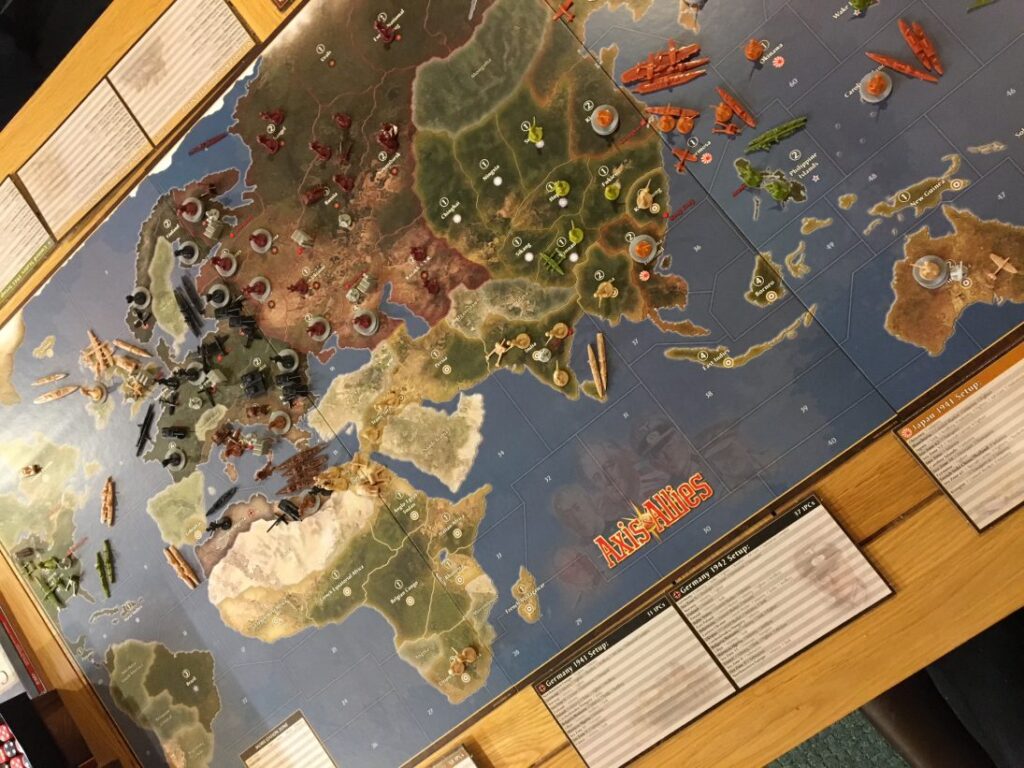
Games of Axis & Allies Anniversary Edition take upwards of three or four hours on a good day, and that’s really only possible when you have two players controlling all six nations. Full disclosure, I’ve played two full length games with two players and one with three, as well as a couple of games that didn’t run their full length because frankly, there’s a long wait between turns. At six players, it could conceivably take more than half an hour between each turn if others are slow to make decisions, and that timeline is based on players who know what they are doing.
I knew a lot of that coming into Axis and Allies, but having never played the game before, I kept wondering what the payoff was and why the game is so eternally popular? It didn’t actually take long to come up with the answer. Firstly, Axis & Allies has spectacular table presence even based on the initial setup that either of the detailed 1941 or 1942 scenarios provides, but more than that, I don’t think I can imagine a better or more detailed way to play toy soldiers. There’s no wonder that people my age refer to Axis & Allies among their cherished childhood memories of board gaming and why they still play it now.
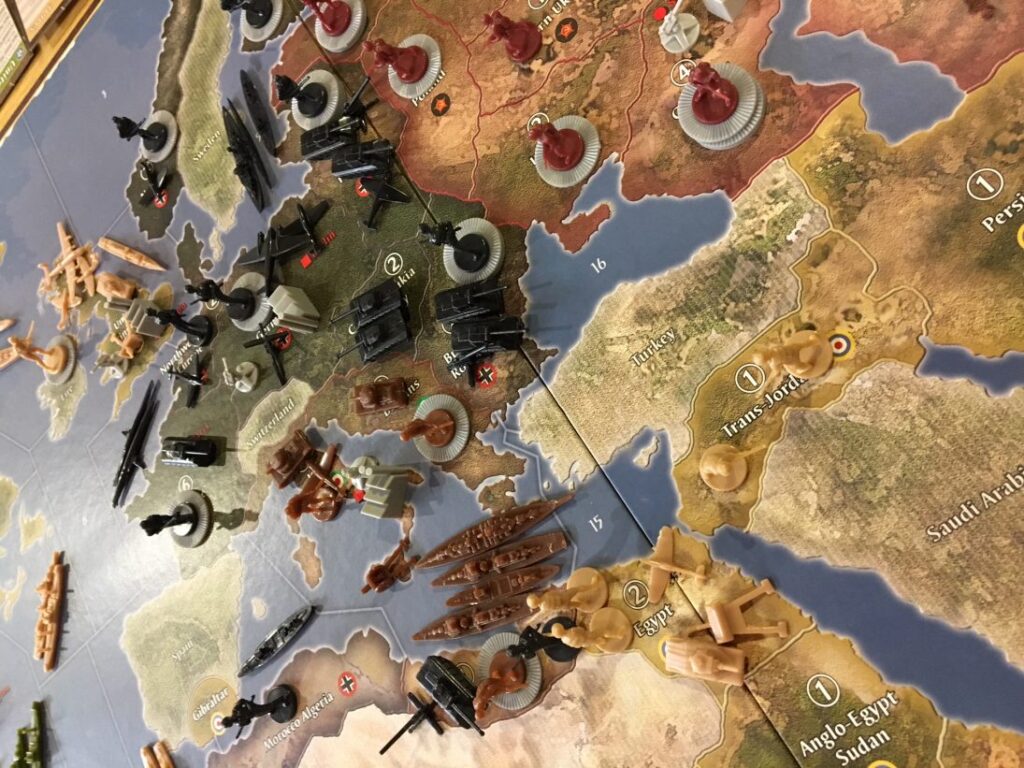
The Anniversary Edition feels absolutely unrestrained in this regard. In the 1941 scenario (which I would say slightly favours the Allies,) every nation besides Italy has an incredible number of units on the board, but even that pales in comparison to the 1942 setup which features a staggering numbers of units, especially for Germany. Thankfully the American and Russian forces are much more developed in that scenario as well, or else the ideals of freedom and democracy would be almost impossible for the commonwealth forces of Britain to defend.
Because the Anniversary Edition takes place on such a grand scale, it does a fantastic job of showing just how encompassing World War II was. Commonwealth forces are drawn from Canada, India , North Africa and Australia, as well as Britain itself. The Chinese are represented as an independent nation that is controlled by the American player and in a nice historical nod, they even have access to a US fighter squadron called The Flying Tigers.
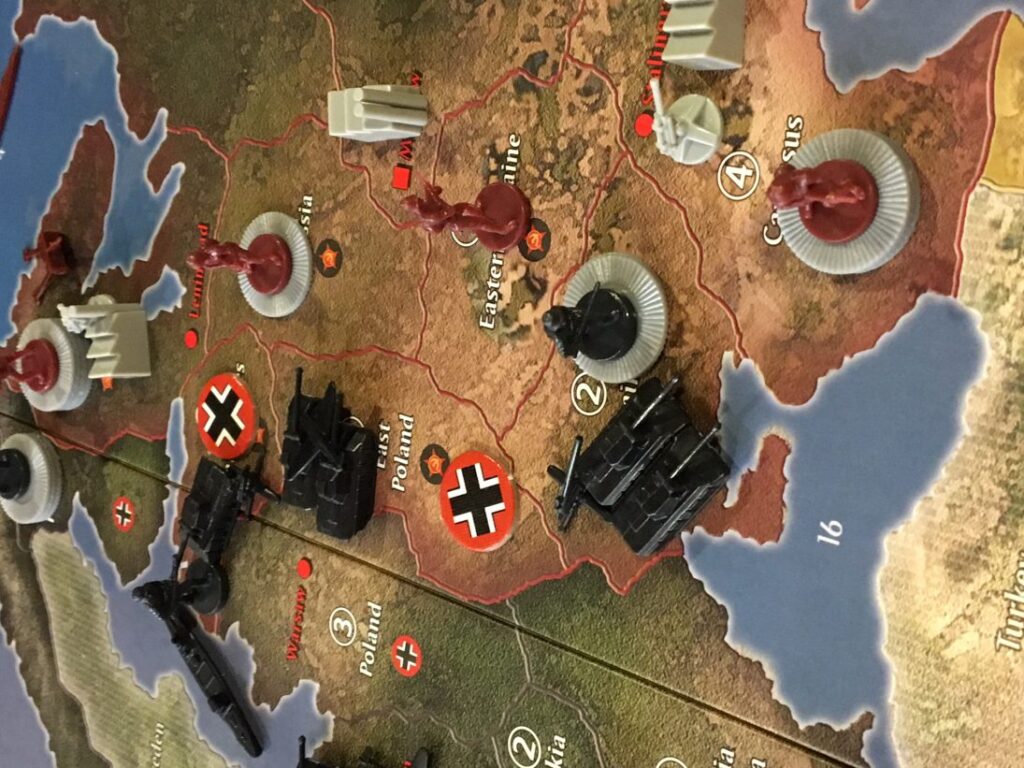
Because of this global scale, conflicts in the Anniversary Edition take place in a number of historically accurate and interesting locations, but as the game goes on and forces inevitably break through in one location or another, things begin to change. In our first game, for example, the Japanese were able to take control of the Pacific sea from East to West, hemming the American’s in on the West Coast and forcing them to turn their attention towards Europe. This led to the British capitulating in India. The basic Chinese force of infantry was powerless to stop the mechanised Japanese army who would surely then have turned their attention to the Middle East, Australia and the Soviet Union.
In the same game, the Italian army made good progress into Africa, whilst the Germans were wiped out there entirely and were beginning to look extremely vulnerable fighting both the Eastern and Western fronts in mainland Europe. In my first six player game, the Italians (who are the least predictable and easily least powerful nation in the game) made a break for South America, and looked likely to capture Brazil, a valuable source of IPC’s for the American player.

IPC’s are the in-game currency, and at the end of each turn, players draw the appropriate number of IPC’s for their nation based on the amount of production across all the territories that they control. Rather than have players tot up lots of little numbers, the game provides a handy tracking board that makes it easy to keep track of shifts in production. Advancing your production of IPC’s is a key early game strategy for all nations really, but it is particularly important for some more than others depending on the scenario.
The game seems to set this up in both scenarios with the fixed turn order and the positioning of starting units. For example, whilst Germany is not as strong as it might like at the beginning of the 1941 scenario, it does have the first turn and should be able to advance hard into Russia, whilst the Italians are expected to have a fighting chance in Africa. The Japanese have lots of options which include pushing into China, invading the USA or just focussing on Pacific island chains where American troops are already stationed.
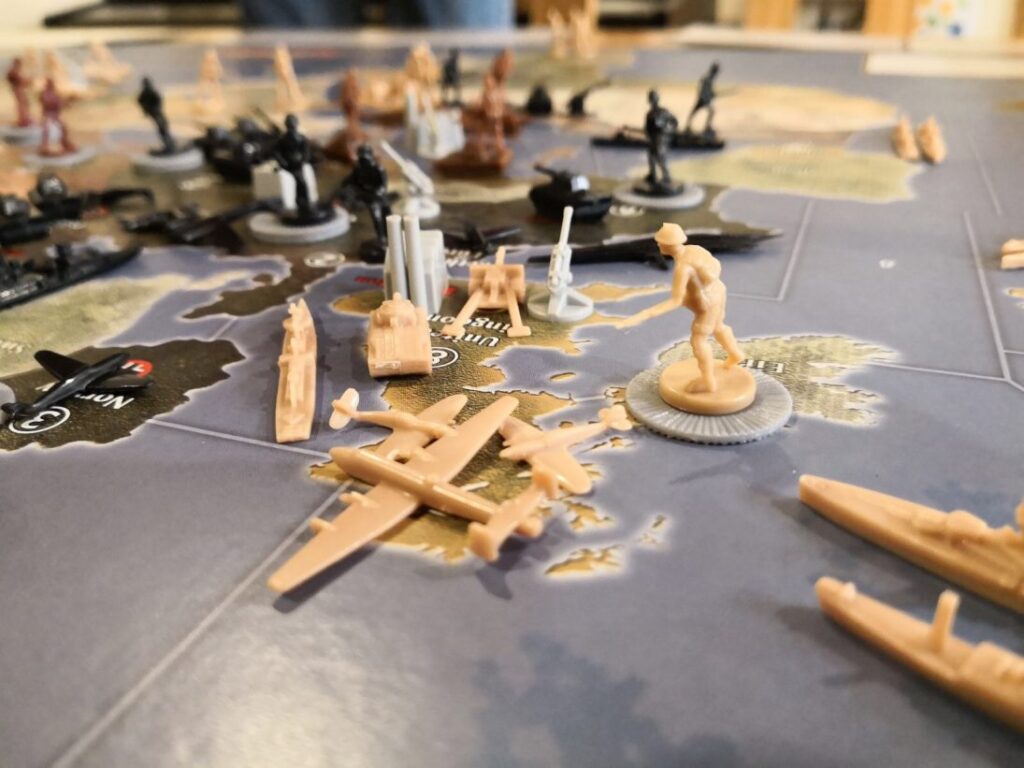
The way IPC’s are spent is interesting, because whilst the actual purchase of units happens at the beginning of your turn, those units are not actually placed onto the map until the last phase of the turn. Even then, they can only be placed in zones which have an industrial facility (represented by a factory model,) which are both expensive to build (15 IPC’s each) and infrequent at the beginning of the game (most nations have just one except for the Soviet Union and the USA.) The limit of units placed is based on the production value of the zone in which the factory is placed and that value can be reduced as the result of strategic bombing raids. Thinking about deployment and how you’ll defend your expanding territories is key, as is when to invest in a new factory.
The ultimate objective of the long game is to gain control of the eighteen strategic tokens, each of which represents a key city like London, Berlin, Manila, Rome, Beijing and so on. A shorter game can be played where the winning player needs fewer tokens, and it does perhaps offer a more realistic situation where the nations would likely agree to some form of diplomatic outcome prior to being completely annihilated. Again, these tokens are distributed in a one-sided way at the beginning of both scenarios, but the intention is clearly for some to be won immediately by the nation that acts first.
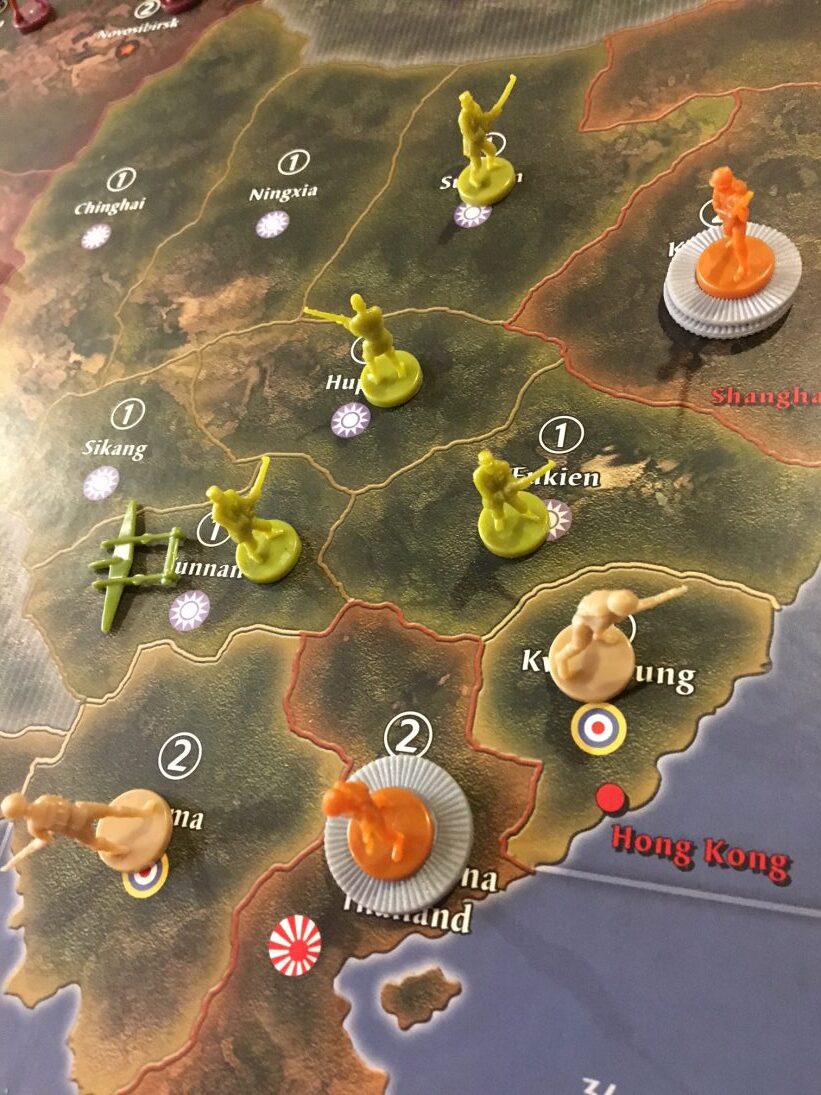
Because it takes place at such a grand scale, combat in Axis & Allies is simple, but it’s also quite interesting because often, so many units are involved. Once all attacks are declared, players resolve conflicts one by one using the Battle Board. Units on both sides are placed on the board, which visually represents the attack and defence value of each unit. The attacker then rolls dice for units of each strength, with the aim being to roll less than or equal to the number for that unit type. For example, tanks must roll a three or less to hit. For every hit, the defender then places a unit (of their choice) into the casualty zone, then returns fire based on the same system (although some units have different values for attack and defence. Defending casualties can always return fire before being removed from battle, so once both players have rolled, casualties on both sides are removed back to the box.
Combat continues in rounds like this until all units on one side or the other are destroyed, assuming that the attacker chooses to keep pressing the attack. If, at any time, the attacker decides that their losses are too great and that victory is in doubt, they can choose to make a tactical withdrawal. There are several complexities to combat that are explained in the manual relating to, for example, infantry supported by artillery, submarine surprise attacks (and how destroyers cancel them) and more. Whilst I found the instructions on battle to be generally easy to interpret, I found that not being able to defend factories from bombing raids with fighters (only AA guns can stop them) was weird, as is combat between fighters and tanks, for example. It isn’t clear whether artillery that is supporting infantry can also fire independently, so I had to fill in some blanks for those kinds of thing.

Overall, the component quality in Axis & Allies is acceptable given the price point. The models are plentiful and quite detailed considering their size, but my version of the game had a few manufacturing defects. Wonky planes, a field gun that was only half cast and that kind of thing. Because of the quantity of pieces, this never became a problem and actually, I use the wonky plane to represent the Chinese Flying Tiger unit, because it is otherwise represented by an identical US fighter that might have become mixed with the rest. On that note, I did have an issue distinguishing destroyers from cruisers and transports, but as long as everyone can agree then it’s easy to work around. It’s also nice that many of the figures for each nation are unique from one another, for example Japan has tanks that differ in design from those of Germany or Britain. The board itself is fantastic looking and made to a good standard, whilst the supporting boards and tokens are all fine without being remarkable.
If there is one thing I do particularly like about the design of Axis & Allies, it is probably the gigantic box and the fantastic organisation system that it includes within. The pieces for each of the six nations are contained within their own separate little boxes, and then there are two more that include all the generic tokens and pieces. When placed in the box, these come together to form a detailed painting of a number of period weapons, which I think is a very neat touch. The manual itself is a bit overly wordy and you can tell that it has been brought together to accommodate multiple different updates to the original, but it is nonetheless acceptable and can be understood within just a few reads.

Most players that experienced Axis & Allies Anniversary Edition with me did leave the table feeling as if they had spent their time well. Anyone playing as the Italians is likely to feel a bit less impressed, but as I said earlier if they are approached with a sense of adventure (I took charge of them to save anyone else the disappointment in our six player games) then they can have an impact on the game. Everyone agreed that whilst the game appears daunting at first, that is due to the scale, and the rules and mechanics are actually quite simple. Strategic thinkers absolutely loved the game (myself included) and this is what led us to play more of the games with fewer players through to completion.
In summary, I have to refer back to what I said earlier. There has never been (in my opinion) a better way to play toy soldiers at home than by diving into the global drama of Axis & Allies Anniversary Edition. It does feel like an older game in terms of its mechanics, its manual and some of the weaker components, but it is also just such a spectacle. I can’t imagine that anyone is going to want to play it due to the unavoidable investment of time, but I do love its grand vision, its massive scale and the simple idea of expanding, building and expanding again – all the while keeping a close eye on your opponents. If you’ve ever wanted to feel like a general pushing flags around on a map, then Axis & Allies Anniversary Edition gives the chance to do exactly that.
Be forewarned! The publisher ( wizards o the coast) does NOT support this product and will not replace the well-known defect of the map. The map quality is bad and warps easily. It will not
lie flat. Customer service is completely uninterested in rectifying the problem. Do not buy this product!